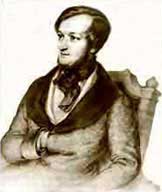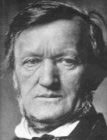OPERATION SWANLAKE
(2028
- 2029)
|
RICHARD
WAGNER - BIOGRAPHY |
 |
The greatest composer of German opera, Richard Wagner, b. Leipzig, May 22, 1813, was the youngest of nine children of Friedrich and Johanna Wagner. His father, a police registrar, died 6 months after Wagner was born, and his mother was remarried the following year to Ludwig Geyer, an actor and portrait painter, who moved the family to Dresden.
Geyer died in 1821, and in 1827 the family returned to Leipzig. Wagner was attracted to the theatre at an early age.
His formal music training was brief - about 6 months in 1831-32 with the Leipzig cantor C.T. Weinlig. During the 1830s, Wagner held a series of conducting posts with small theatrical companies, and he wrote two operas, Die Feen (The Fairies, 1834) and Das Liebesverbot (Forbidden Love; after Shakespeare's Measure for Measure); His third opera, Rienzi, was conceived on a larger scale, and Wagner travelled to Paris in 1839 with the futile hope of having it performed there. Rienzi was finally accepted for performance in Dresden in 1842. Its success, coupled with that of Der fliegende Holländer (The Flying Dutchman) the following year, led to Wagner's appointment to an official conducting post in Dresden.
There he
completed Tannhäuser (1845) and Lohengrin
(1848). This period of success ended in 1849, however, when his participation
in revolutionary political activities forced him to flee to Switzerland.
Wagner's exile from Germany, which lasted until 1860, marks the start
of a new period in his career.
Wagner began composing the non-conventional opera-cycle Der Ring des
Nibelungen (THE RING OF THE NIBELUNG) in 1848 and did not finish until
1874.
 |
The
last great turning point in Wagner's fortunes occurred in 1864 when
he was called to Munich by the eccentric young king of Bavaria, Ludwig
II, an ardent admirer of his works and theories. Ludwig's patronage
continued for the last 20 years of Wagner's life, making possible
the performance of all his mature works and eventually the construction
in Bayreuth of a theatre of Wagner's own design. It was opened in
1876 with the first complete production of the Ring. Bayreuth soon
became the centre for the promotion of Wagner's works and ideology.
His last opera, Parsifal, was performed in 1882, with the ceremony
normally accorded only to a religious event.
Following Wagner's death on Feb. 13, 1883, control of the Bayreuth festival passed to his second wife, Cosima (a daughter of Franz Liszt), and later to their children and grandchildren, a succession that has continued to the present. The use of legendary sources and the gradual reduction in contrast between aria and recitative in these operas anticipate the new music drama that Wagner was to propose in the treatises written about 1850. The guiding principles of his theory were naturalism and dramatic truth, which he felt had been compromised by the musical conventions of contemporary opera. |
He advocated a new synthesis of music, verse, and staging - what he called a Gesamtkunstwerk. The verse, which Wagner always wrote himself, was to be compressed, metrically free, and alliterative, dispensing with the end-rhyme that led to closed musical structures. The open-ended melody of the vocal line was to be supported by a symphonic accompaniment, continuously fluctuating with the sense of the text and unified by a web of motifs associated more or less directly with characters, things, ideas, or events.
Wagner called these motifs Grundthemen, but they have become better known as leitmotifs ("leading motifs").
This theoretical music drama was exemplified in its purest form in "Der Ring des Nibelungen".
© Institute of Militronics and Advanced Time Interventionality 2058
back
to OPERATION SWANLAKE textpage
Time Travel Research Projects menu
